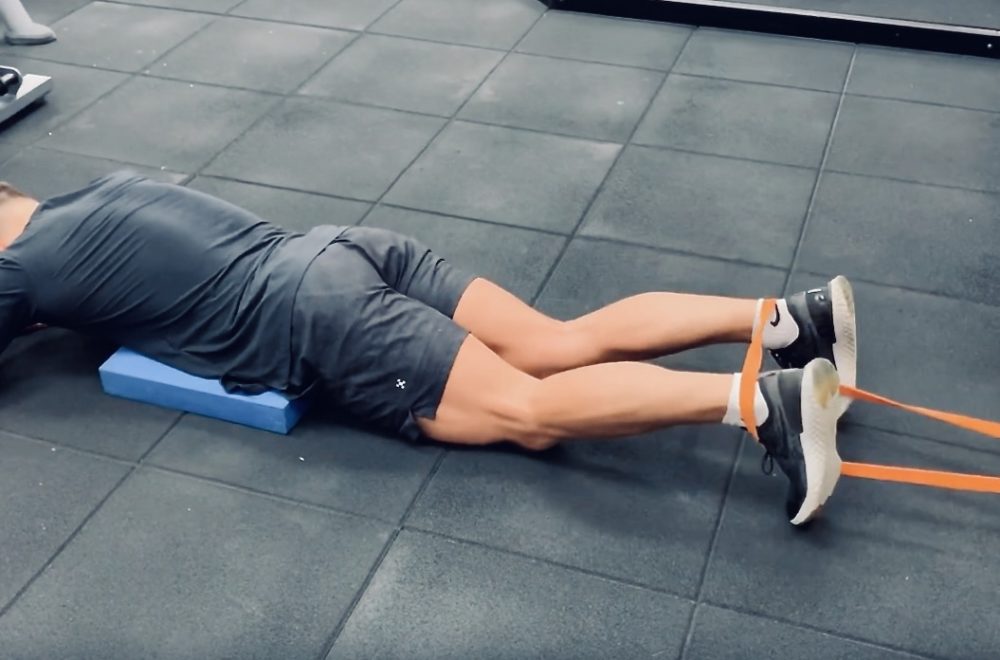Resistance bands can be one of the most versatile pieces of exercise equipment for at home, as well as vacation workouts. Here’s a database of fundamental lower body band exercises to help you mix up and progress your bodyweight workouts.
See HERE for upper body band exercises
See HERE for band exercises to work your core
Banded hamstring curls are an effective way to target your hamstrings in isolation. Most of the resistance occurs when your hamstrings are in their fully shortened position. Use these as a higher repetition burner, or to pump up your hamstrings before a heavy quads workout (ready about this trick HERE).
It can often be a challenge to target your lower body with just bodyweight alone. Adding a resistance band to your squats is a simple way to increase resistance. Since you’re stronger at the top of a squat than at the bottom, a resistance band matches this strength profile to add more load where your strongest. Use a front racked position or go Cali style.
Banded goblet squats are a personal favorite. There’s a lot you can do from this position. Try a banded drop set if you’re feeling supper sadistic.
If you have a weightlifting or dipping belt laying around, these are a neat way to annihilate your quads. All you need to do is loop the band over the belt then squeeze your feet in to each end. To read more about these and hip belt squat variations I wrote about them HERE.
Take the banded hip belt squat, add in a drop set and you’ve got one evil band exercise finisher. Enough said.
Placing more emphasis on single-leg band exercises allow you to train with greater intensity, since more weight is placed on one leg at a time. Single-leg exercises are also help develop functional strength and size, while giving you the opportunity to work on your shocking show of balance and stability. Hold the resistance band further down to keep tension in the bottom of the split squat. The slight forward angle of the band helps to make these a little more quadriceps-dominant, too.
A front-loaded split squat allows the resistance band to stretch a little further, and for some easier to maintain this position than holding a resistance band. This method is more accommodating to a heavy resistance band, if you have one available.
Taking your banded split squat to a rear foot elevated position is a way to challenge your single-leg strength even further. Placing your back foot on a bench or chair acts to take the back leg out of the equation somewhat, and allow more emphasis on the front leg. Use rear foot elevated as a progression from your regular split squats.
If your band resistance is too light and you need to up the ante, consider using some intensity techniques. For example 1.5 repetitions, slow eccentrics, tempo sets, isometronics, pulse finishers, or even simply adding in an isometric hold at the bottom of each split squat.
The session technique is another intensity technique. If you have some dumbbells then give this a go: Start with both dumbbells and band resistance, then drop to the dumbbells alone, then a final drop to the band alone. It’s horrible, in a good way!
Don’t forget to add in some lateral movement to your lower body band workouts. The frontal plane is often neglected, so to spend some time there will help to benefit your overall health and performance, while also hitting some muscles you may have forgotten!
Single leg Romanian deadlifts (RDL’s) are another good single-leg band exercise. The don’t compare to a dumbbell or landmine RDL, say — where there’s more loading of your hamstrings in a stretched position — but when your options are limited are a viable substitution. These can also be used as part of a warm-up routine for your regular strength training workouts.
Step ups can be done on a chair or park bench. Adding a band in this way increases horizontal resistance which has a good transfer to sports and athletic movements, as well as help promote a little more butt action. If you have some dumbbells then even better.
Cable pull-throughs are on par with back extensions and reverse hypers for developing posterior chain strength in a manner that relatively spine friendly. Loop a band around a post somewhere and boom… you’ve got yourself an effective banded pull-through setup. These will work to load your glutes mostly in end-range, while also getting a good stretch at the bottom (pun intended!).
If you’re regularly bridging or hip thrusting a stack of plates on either side of a bar, then a band isn’t going to do it much for you. But when options are limited it’ll be one of your best options. These’ll target your glutes in end-range at the top of the bridge. When using a lower resistance than you’re used to, placing your ankles in dorsiflexion can assist in making the exercise harder and promote glute activation.
If you have a couch, chair or bed you can do these on (of course you do!) then hip thrusts will increase glute activation further than hip thrusts will. You’re typically a little weaker in a back elevated position versus on the floor during glute bridges, so you’ll achieve greater intensity here.
You’ll need a high-strength resistance band for this one, or double up some lighter ones. Attach your band to the bottom of a post or anything that’s sturdy. Use a pad or cushion for your knees, and have a chair in front of you. Once you’re in position, the execution is like a barbell hip thrust, but you’ll be kneeling. This ones great for your glutes. Just don’t make eye contact!
Terminal knee extension is kind of a fancy way of saying you’re working the last few degrees of knee extension. These are a good substitution for something like a leg extension machine, where you’re looking to isolate your quads. These are arguably a little more knee-friendly than a leg extension machine too, and frequently used in rehabilitation settings.
Sometimes called hip-drop fire-hydrants, these are a creative way to load your glutes through bent-knee hip abduction. Here I’m using an NT loop — it’s a more comfortable band to have for exercises where it’s in contact with your skin — but a regular strength band is fine. The hip drop works to further emphasise the glutes stretch.
X band walks isolate your hip abductors and external rotators. You can do this in a taller position and emphasise more hip extension too. As a glutes isolator these are great in any setting. Travel from one side of your room to the other, or just perform a box step.
Monster walks are a creative way to hit your glutes and hamstrings. Unlike the x band walks shown above these are a little more focused on hip extension, due to the placement of the bands. If you have a low post to tie a band around, there a re a good way to either start or finish your lower body band workouts.
See HERE for upper body band exercises
See HERE for band exercises to work your core
To find out about Online Strength and Physique Coaching click HERE.

I build Olympians, Cover Models and those who want to look like them. Author or “Ultimate Abs” available in all good book stores.

Hi, thanks for the exercises. Which brand of band do you use?